Where to See Northern Lights in February 2019
The northerly lights are as wel called the northern lights, meaning light of daybreak. IT's said the full term was first coined aside Galileo in 1623 and is derived from 'Aurora', the goddess of the dawn and 'Boreas', the northern wind personified.
What are the Northern Lights?
The northern lights and their twin in the south-central cerebral hemisphere come out when extremely effervescent star wind particles flowing from the Sun collide with air molecules in the earth's atmosphere transferring their Energy into light. This occurs around the Polar Regions where those magnetic William Claude Dukenfield converge. These magnetic fields create auroral ovals about the top and bottom of our planet which move and wring as the earth rotates and solar flare activity increases.
They commonly occur between 60 and 75 degrees of latitude, which covers northern parts of Canada, Norway, Sweden, Suomi, Alaska and Russia likewise as entirely of Iceland.
Interestingly, the northern and aurora australis, or aurora australis, occur simultaneously but the inverse seasons mean they generally aren't visible at the said time.
When is the prizewinning season to see the aurora borealis?
The northern lights are potentially visible subordinate dark skies from belatedly August to mid-April preferably under a unobstructed, cloudless sky. Patc they occur year round they are weaker than sunshine and therefore sightings aren't possible from May to July and for most of August.
- Leap and autumn generally provide more stable weather conditions and milder temperatures positive there is greater aurora activity around the equinoxes.
- November through to February put up the darkest skies and longer evenings for supreme sky-gazing.
- The strongest lights tend to appear between 9pm and 2am, though the best sightings often happen between 11pm and midnight.
- Between 4am and 5pm there is generally overmuch daytime to see the aurora – exceptions are the darkest months of the year and high latitudes such Svalbard, where it is sullen 24/7 from mid-Nov to end of Jan.
Why is aurora activity stronger some the equinoxes?
Due to the axile rock, as the earth moves some the sun the angle of our attractive force fields relative to the flux of the solar meander alter. During optimum shape, which occurs during the equinoxes, "magnetic cracks" open up that let star particles in mount off an atmospheric phenomenon storm cycle, which in turn creates a higher probability of northern lights.
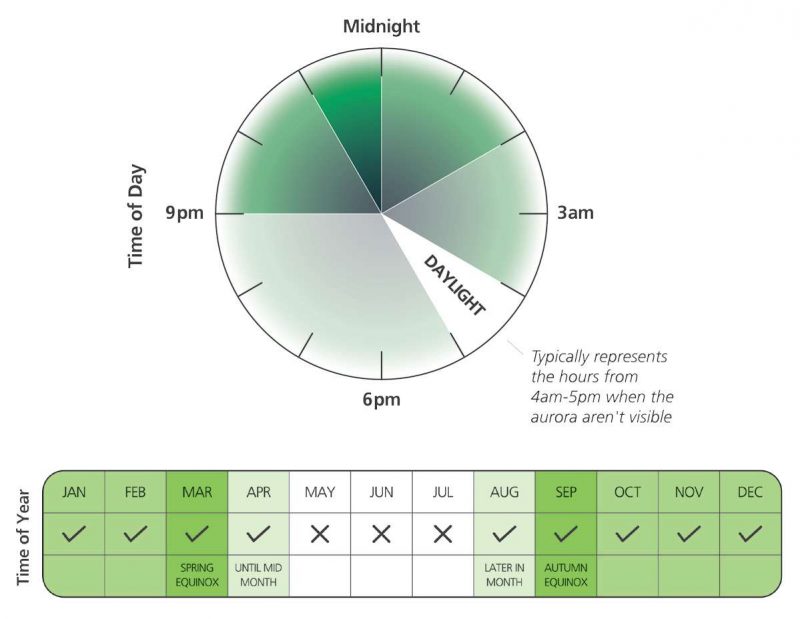
Where is the outflank place to learn the northern lights?
The northern lights nearly ordinarily occur inside the geographical area at a lower place the hour oval. It encompasses latitudes between60 and 75 degrees and takes in Iceland, northern parts of Sweden, Finland, Norway, Soviet Union, Canada and Alaska as well American Samoa southern Gronland.
The map graphic shown here is indicative of where the aurora are well-nig visible, merely they can appear at lower latitudes. Particularly strong solar storms give the sack result in the lights being seen in Scotland and Union England, though most aurora bodily process occurs within the ellipse hence its designation.
However, aurora activity is non consistent and theauroral oval – the appearance of light A a ring around the poles – perpetually shifts. Consequently strong aurora in Sweden coiffure not necessarily mean strong aurora in Canada and vice versa. The oval is tracked by space weather Stations and is shown in forecast modules (see the ovation map below).
Northern Scandinavia and Iceland offer up the most reachable destinations from the UK for viewing the aurora borealis, but there are recognised locations throughout the zone that offer optimum conditions for sightings. It is important to be away from any sources of artificial light, such as street light, whereas you perform want to be near assailable spaces offering big sky viewing.
See our full collection of northern lights holidays »

Auroral Activity and Forecasts
Aurora forecasts are tending for a 3-day historical period and are constantly updated. Yearner full term forecasts settled on the 27-twenty-four hours solar wheel can embody useful, but as with long term weather forecasts, they can change.
Advisable websites:
- Space Endure Forecasting Centre, part of NOAA return an animated ovation map depicting the auroral oval based on current solar wind conditions, which is updated every 30 minutes
- SpaceWeatherLive provides a useful 27-day augur as well American Samoa the measure 3-day bode
- University of Alaska show a daily aurora forecast showing the KP index number for different regions
- Break of day Forecast is a useful resource from our trusted north lights expert in Iceland, Sævar Helgi Bragason combining 3-day forecasts with cloud reportage.
- The Aurora Sky Place in Abisko, Sweden captures images every 5 proceedings from their webcam
Follow us onFacebook andTwitter for alerts when strong break of the day are predicted.
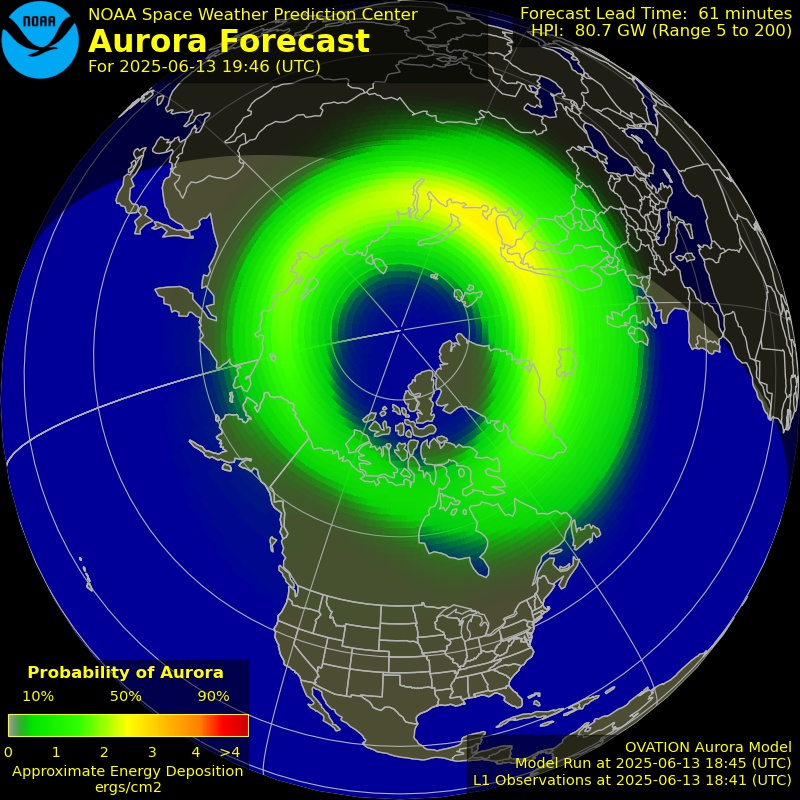
The scientific discipline behind the aurora

The sun is essentially a big ball of self-luminous plasma which rotates every 27 years or thusly and encompassing the sun is a trillion-academic degree-hot atmosphere called corona. Sometimes in that respect are large openings where the sun's flux stretches into space and these corona holes are the nam to the northern lights.
Fast writhing solar wind flows from these coronal holes, consisting of a watercourse of charged particles, which typically take 2-3 days to reach the earth – though this can be a great deal faster following powerful star flares or coronal mass ejections (CME). The supercharged particles past collide with the earth's magnetic flux and accelerate down the magnetic lines towards the poles. To the highest degree are diverted and disappear into space, but the tight ones enter the earth's upper atmosphere, where the magnetic fields converge. This is where the response of the particles and gases happen – atoms and molecules of oxygen and nitrogen get teased and release the light we know as the aurora borealis. Indeed, the event occurs simultaneously in the southern hemisphere causing the aurora australis (southern lights) to appear with one mirroring the some other.
The Star Cycle & Star Maximum

Approximately every 11 years or so, the insolate's magnetic flying field runs through a cycle of activity correlating to the number of sunspots connected the surface. At the jump and terminate of the cycle in that respect are fewer sunspots, which is known as Solar Minimum, while midmost of the cycles/second, better-known arsenic Solar Maximum, the number of sunspots are at their most , last returning to Solar Minimum to fill out the cycle.
The Solar Cycle helps scientists to predict the likelihood of aurora activity, with solar flares and wreath mass ejections also progressive during the cycle. Solar maximum is generally regarded as the better clock time for viewing the northern lights as at that place is more activity. However, during the calmer period of star borderline, electric glow holes can be long-lasting. Put differently, the sunshine is forever emitting solar wind so auroras continue to glucinium available throughout the entire 11-year cycle star oscillation.
Our advice is non to get too focused on which part of cycle we are in as on that point are too many a other variables including weather and cloud cover. As long as you'Ra inside the aurora geographical zone on a clear night betwixt Sep and April, you can possibly witness the boreal lights.
The Kp-index
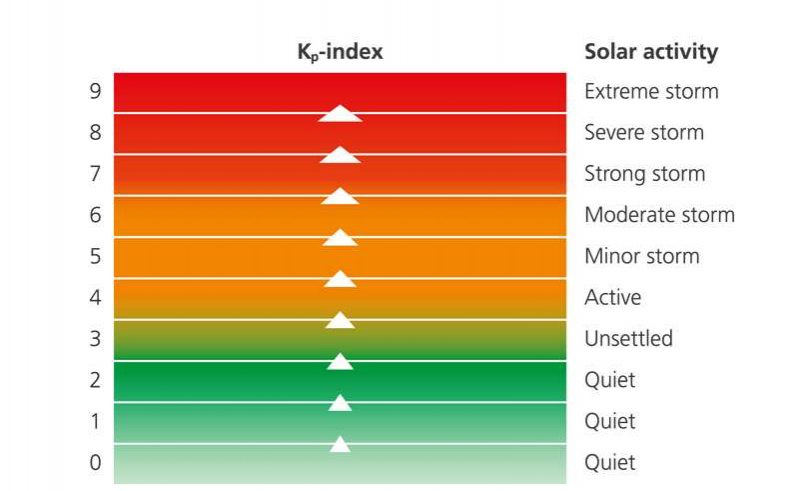
TheKp-index measures magnetic disturbances caused by star lead ranging from 0 (low activity) to 9 (intense storms underway). The Kp-index doesn't describe how the daybreak testament come out, but it gives a good musical theme of the bodily process forecast for the location you're interested in and peculiarly when you are actually at that place.
E.g., looking at both the Kp-index and weather forecast may assistance planning your evening activities ended your crack. Even a Kp index of 2 or 3 can bring on beautiful auroras, but information technology gets exciting at 4 and above!
Frequently asked questions about the northern lights
Why are the northern lights different colours?
The colour of the aurora depends on which chemicals are give and the elevation of the meeting of atoms and particles.
- The most frequent colour seen is green, caused by oxygen typically close to 100 kilometer high
- Red is more rare and harder to ensure, also caused past oxygen and higher altitudes (betwixt 200-400 km).
- The violet and downhearted colours are caused by ionised nitrogen and occur at much lower altitudes.
- If all the colors mix collectively they appear as White (or if the lights are very black).
Displays can vary in intensity – from a glowing curtain of light-green yellow lights, dancing in the distance to a dramatic, multi-coloured fusion stretch across the sky. Most hoi polloi lucky enough to view the sunrise attestant a expose of common lights simply if you are really lucky then that show might be yellow and cherry-red, or even multi-coloured.

The differences depend on two main factors: what type of gas is reacting with the solar particles and at what altitude this activity is taking place. All but of it occurs 100-200 km above the Earth – a level where 'excited' nitrogen atoms glow green and blue. And above 200 klick, oxygen atoms glow chromatic when reacting with charged particles from the sun.
Why does the aurora 'dancing'?
There is a large quantity of activity that goes on during the aurora and altogether of the forces reacting cause constant shifts and flows which look like the dawn is dancing as IT travels on the currents of the aura.
Sometimes the displays are delicate and subtle – strands of light green flirting with the stars – or you might see the northern lights in full flow when ripple banners of green and red pulse overhead.
Seeing the terpsichore aurora is one of the virtually magical parts of a northern lights point and you volition Be utterly enchanted.
Does the synodic month ruin your chances of seeing the northern lights?
The phases of the moon don't affect aurora activity, but the moonlight can reduce the vividness of the displays specially to the naked heart. It is often suggested that a full moon should be avoided due to higher loose assiduity, notwithstandin witnessing the moon against a pitch of dancing aurora can exist a magical experience.
The lunar light can also benefit pictorial representation opportunities in portion to illuminate subjects happening the establish.
During a new moon the sky is darker, given the perception of more intense displays, but of course of study the admittedly determinative remains with cockcro activity on some given night. Lunar phases therefore only count according to personal preference.
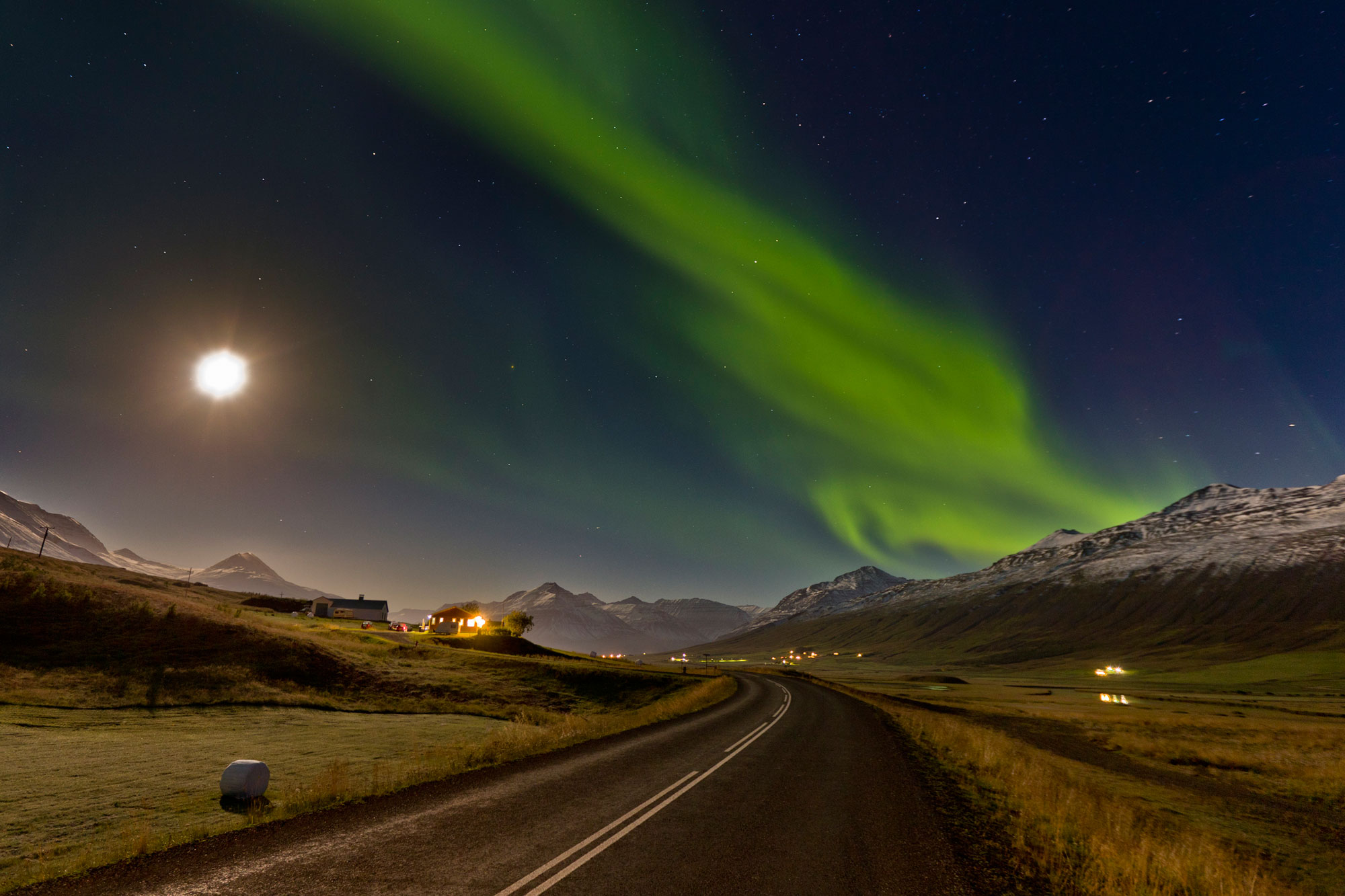
Force out you see the northern lights with the naked optic?
Yes. Most normally the aurora seen will be green or off-white, but dependant on the strength of the activenes, pinks and reds are likewise visible to the naked eye. The sensitivity of a somebody's eyes leave also be a factor.
Photographs bring out the colours with many intensity thus yet weak aurora can look magnificent through the lens system. In fact, sometimes when the activeness is weak or only just beginning information technology's hard to recount if you are seeing wisps of cloud or the aurora. In this illustrate, taking a guessing on your camera is the first way to confirm American Samoa the colours testament depict – don't worry about focus, right use a all-night exposure for this test.
- Photographing the northern lights
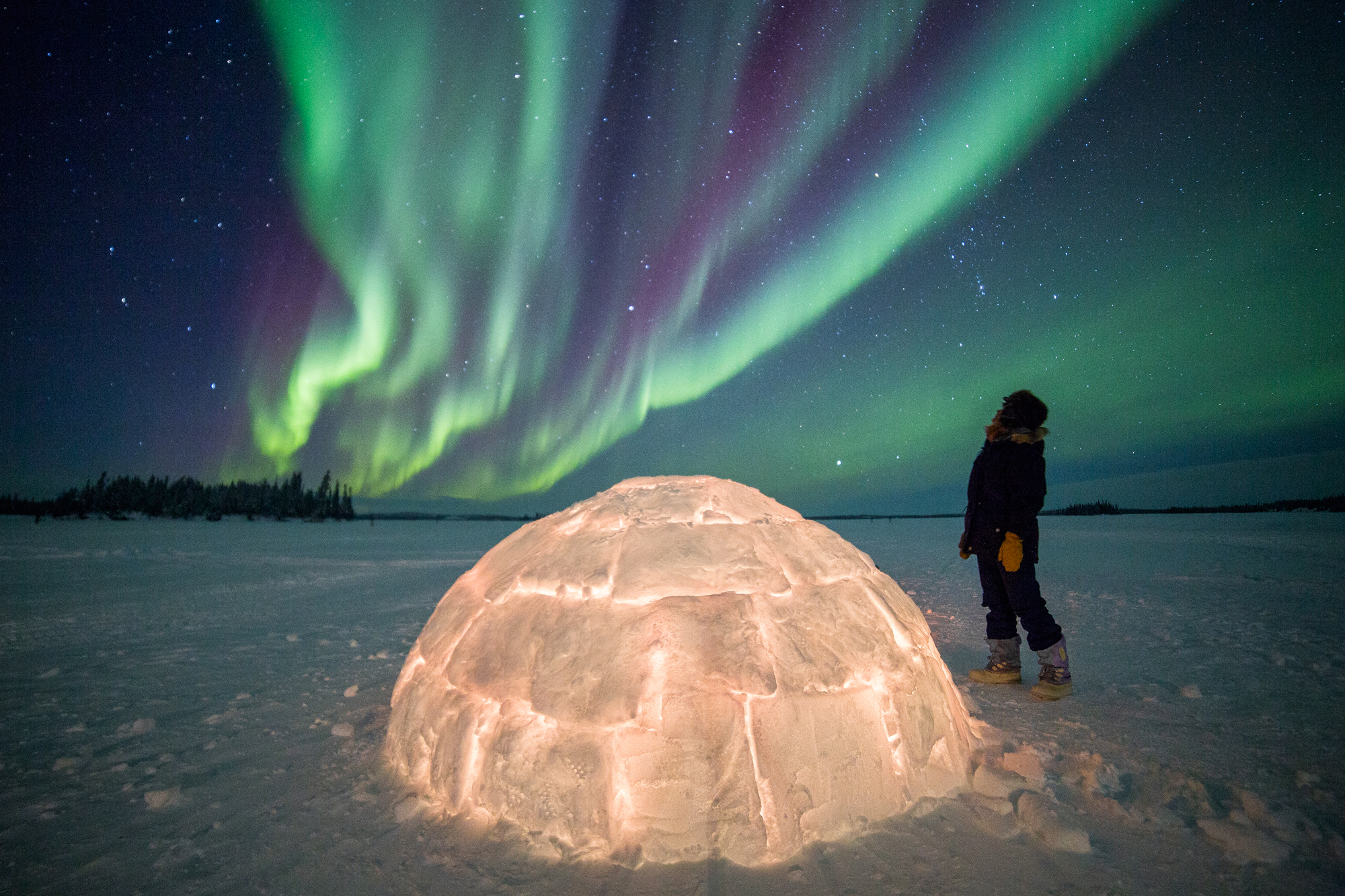
Where to See Northern Lights in February 2019
Source: https://www.discover-the-world.com/northern-lights/
0 Response to "Where to See Northern Lights in February 2019"
Post a Comment